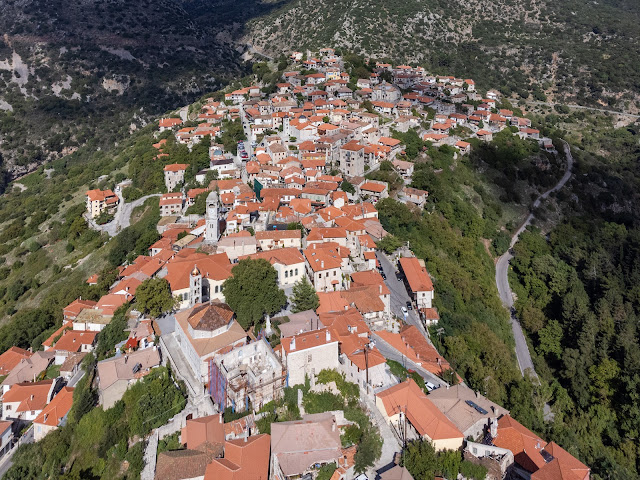The Land of Homer and the Odyssey
The Peloponnese is a
peninsula located in southern Greece that is steeped in history and culture.
From ancient ruins to pristine beaches and picturesque villages, this region is
a must-visit destination for anyone traveling to Greece. In this blog post,
we'll take a journey through the Peloponnese and explore some of its most
fascinating attractions. The Greek word Peloponisos in translation means
"Pelops' island".
There was also a large wall that protected
the Peloponnese from barbarians from the north, and the coating was
symbolically considered to be the symbolic body of their great-grandmother, the
goddess Gaia. The Romans, Alexander the Great, tried but failed. A French
construction company started work and after 12 years succeeded. The Aegean and
Ionian Seas joined forces and thus shortened the waterway by 15 hours of
sailing. The length of the Corinth Canal is 6343 meters and is passable for the
largest merchant and passenger ships.

The Peloponnese is divided
into several smaller tourist-geographical regions. To the northeast is
Corinth, named after the city of Corinth. Further south is Mount Artemison
and a large flat plateau. It is Arcadia with its center in Tripoli, an area
marked as the birthplace of Hermes (god of trade). Not far from
Tripoli is the famous Sparta. Despite the knowledge that there was a great
Sparta, archaeologists have not found ancient values in this area. It is the
place where the beautiful Jelena, the wife of King Menelaus, was abducted.

The largest mountain in
the Peloponnese is Taygetus, the third highest after Olympus and
Parnassus. The west coast of the Peloponnese is flooded by the Ionian Sea. The
largest and most beautiful theater in ancient Greece is located in the
Pelponez. The author of this work is Pliclet the Younger, heir to the famous
Kalimah. It was built in 333 BC for 18,000 to 20,000 spectators. It consists of
three main parts - auditorium, orchestra, and stage. In the theater, the
performances were performed with additional sound effects. The whistling of the
wind, rain, or lightning.

In the tame end of the
region of Elis at the confluence of the river Cladeos and the river Alfeos, a
sanctuary was built for all the Olympian gods and named Olympia. the neighboring
games the Greeks called the "Olympics". Competitors applied for
the Games and after control checks, they stayed in an institution called
Gimnastirion for a year with daily training, a strictly controlled diet, and a lifestyle. further, running two lengths of the stadium, three lengths of the stadium, and five mixed disciplines. The basic condition for a young man to participate in
the Games was that his mother tongue is Greek. Being an Olympic winner was a great
honor. He could make his votive gift. to the god Zeus, not to the holy throne
around the temple itself. There were no medals, but the best in their
discipline would be crowned with an olive branch.

Along the Peloponnesian coast lie two groups of
islands: the Argo-Saronic Islands, in the east, and the Ionian Islands, in the
west. The island of Kythira, near the Epidaurus Peninsula in the south, is
considered part of the Yong Islands. What I must mention at the very end
is that the island of Kythira will certainly not leave you indifferent. Also,
the small island of Elafonisos with its crystal clear, turquoise water attracts
the attention of many tourists who love passive vacations.
The Peloponnese is home to
some of the most impressive ancient ruins in Greece. The most famous of these
is the ancient city of Olympia, which was the site of the first Olympic Games
in 776 BC. The ruins of the Temple of Zeus, the stadium, and the gymnasium are
a testament to the ancient Greeks' love of sports and competition. Other notable
ancient ruins in the Peloponnese include the ancient city of Mycenae, which was
home to the legendary King Agamemnon, and the ancient theater of Epidaurus,
which is renowned for its incredible acoustics.
Beaches
The Peloponnese is also home
to some of the most beautiful beaches in Greece. With crystal-clear waters and
sandy shores, the beaches of the Peloponnese are perfect for swimming,
sunbathing, and relaxing. Some of the most popular beaches in the region
include Voidokilia, which is often ranked as one of the most beautiful beaches
in the world, and Simos, which has a stunning lagoon and a long stretch of
sandy beach.
Voidokilia
Scenic Villages
The Peloponnese is dotted
with charming villages that offer a glimpse into Greece's rural way of life.
One of the most picturesque villages in the region is Monemvasia, a medieval
town perched on a rock that rises out of the sea. Other notable villages
include the mountainous village of Dimitsana, which is known for its
traditional architecture and stunning views, and the coastal village of
Kardamyli, which was a favorite of the famous author Patrick Leigh Fermor.
Dimitsana village
Natural Wonders
The Peloponnese is also home to several natural wonders that are worth exploring. One of the most famous of these is the Diros Caves, a series of underground caves that are home to a vast network of underground lakes and rivers. Visitors can explore the caves by boat and
marvel at the incredible rock formations and stalactites. The region is also home to several
stunning gorges and canyons, including the Gorge of the Neda River, which is renowned for its crystal-clear waters and breathtaking scenery.
Gorge of the Neda River
Delicious Food
No trip to Greece would be complete
without sampling some of the country's delicious cuisine, and the Peloponnese
is no exception. The region is known for its hearty and flavorful dishes, which
are often made with local ingredients such as olives, feta cheese, and fresh
seafood.
Some of the most popular dishes in the region include moussaka, a layered dish of eggplant, ground meat, and béchamel sauce, and souvlaki, skewered meat that is grilled and served with pita bread and tzatziki sauce.
Click HERE for information on places to visit in the Peloponnese















No comments:
Post a Comment